Our patient speakers at the Amyloidosis Speakers Bureau are powerful educators and offer compelling insights. Have a listen to this brief clip from Joe with thoughts on physicians being curious and persistent to find answers.
Slider
Patient Insights: I have to advocate for myself
With a rare disease, it is difficult to expect the healthcare community to be fully knowledgeable. Thus being a self-advocate is critically important. Our patient speakers at the Amyloidosis Speakers Bureau are powerful educators and offer compelling insights. Have a listen to this brief clip from Dan.
Patient Insights: Discussing a hereditary disease with relatives
With a hereditary disease, talking with relatives can be challenging. Hear Greg share ways that he has advanced discussions. Our patient speakers at the Amyloidosis Speakers Bureau are powerful educators and offer compelling insights. Have a listen to this brief clip from Greg.
Patient Insights: Diagnosis was a huge relief
Have a listen to this brief clip from Sean with thoughts on getting such a devastating diagnosis. Our patient speakers at the Amyloidosis Speakers Bureau are powerful educators and offer compelling insights.
Expert Insights: Why is amyloidosis so often misdiagnosed?
Dr. Angela Dispenzieri from the Mayo Clinic discusses why amyloidosis is often misdiagnosed. The complexity of the disease and commonality of symptoms are two of the reasons she examines. In addition, she offers guidance on appropriate diagnostic pathways.
Expert Insights: The Future for Patients with Transthyretin Cardiac Amyloidosis is Looking Brighter
The treatment for patients with Transthyretin Cardiac Amyloidosis has advanced significantly since 2018 when there were no FDA-approved therapies. In this presentation, Dr. Mat Maurer from Columbia University shares how diagnostic imaging techniques have significantly improved, thereby reducing the need for an invasive heart biopsy. In addition, he shares fascinating statistics on how the age and stage of diagnosis has been evolving. Based on today’s clinical trials, providers are optimistic that the expansion of options for patient care will continue.
The future is indeed looking brighter.
Diagnosing Amyloidosis: A Two-Step Process
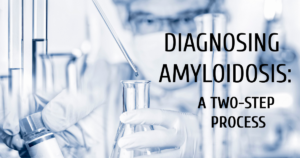
Amyloidosis can present in many types with the three most prevalent being light chain (AL) amyloidosis, hereditary variant transthyretin (ATTRv) amyloidosis, and wild type transthyretin (ATTRwt) amyloidosis. Being a rare disease, diagnosis can be particularly challenging, given that the general medical community is not well educated on the malady and symptoms are often associated with other more common ailments.
Successfully diagnosing the disease requires a two-step process before an appropriate treatment program can be determined and implemented for each patient.
- First, if amyloidosis is suspected, testing must be done to confirm the presence of amyloid.
- Second, once the presence of amyloid is confirmed, testing must then be done to identify and confirm the type of amyloidosis.
It is crucial that the second step, where the correct type of amyloidosis is identified, as the treatment regime can be different for each type. Here we share two different patient experiences which illustrate successful execution of the two-step diagnostic process.
Patient Case #1
The first case involved a 23-year old female. In 2017 she experienced an episode of coughing up blood, after which she looked in her throat with a flashlight and discovered a sizable lump. The patient met with a local ENT, who incorrectly diagnosed allergies, and prescribed over-the-counter medicine. With no improvement, she met with a second ENT. Testing was performed on the patient’s left oral pharynx utilizing a Congo red staining biopsy process which confirmed the presence of amyloid in the tissue. Additionally, mass spectrometry was performed which successfully differentiated the type of amyloidosis as being ALH (lambda light chain and delta heavy chain). Subsequently, she was referred to a hematologist who ordered a bone marrow biopsy and blood testing. The bone marrow biopsy summary notes read “….in conjunction with the concurrent finding of monoclonal lambda light chain restricted plasma cells in the marrow by flow cytometry, the findings are consistent with involvement of the marrow by a plasma cell neoplasm.”
Additionally, the blood testing confirmed elevated light chains as shown below.
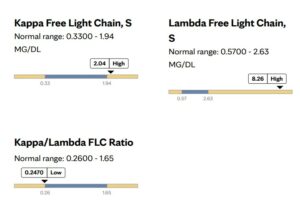
Patient Case #2
The second case involved a man in his mid-fifties. He began experiencing disease symptoms approximately 6-7 years prior to being diagnosed in early 2019. He initially experienced gradually progressing numbness in his feet, legs, hands and forearms, as well as bilateral carpal tunnel syndrome. Soon after, he began experiencing symptoms of lightheadedness and fainting. Additionally, he started experiencing progressive gastro-intestinal issues such as acid reflux, chronic coughing, and frequent bouts of constipation and diarrhea. By 2018, his physical condition was rapidly deteriorating, including a total weight loss of approximately 80 pounds. During this extended period of time he was seen by a variety of physicians including internal medicine, neurology, endocrinology, gastroenterology, oncology, and cardiology, none of who were successful in arriving at a conclusive diagnosis. His list of maladies included cardiomyopathy, peripheral neuropathy, autonomic neuropathy, bilateral carpal tunnel syndrome, and gastroparesis, all which are classic symptoms of amyloidosis.
Finally, in early 2019 his condition was successfully diagnosed by an amyloidosis specialist. An echocardiogram was performed as well as a cardiac MRI (utilizing a gadolinium tracer) to identify amyloid fibrils and related damage in the heart tissue. These tests confirmed the presence of amyloid. A free light chain serum test was performed which ruled out AL amyloidosis, and Transthyretin DNA sequencing was performed to differentiate between the hereditary variant and wild-type of ATTR, which identified the T80A (legacy T60A) variant of transthyretin (ATTRv) amyloidosis. The two tests were successful in identifying the type of amyloidosis. The associated testing results are show below.
Echocardiogram Summary Notes
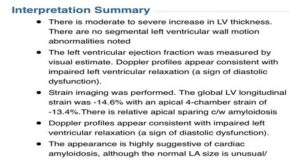
Associated Cardiac MRI Interpretation
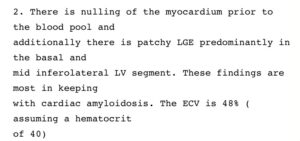
DNA Sequencing Result
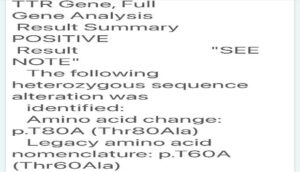
Once Diagnosed, Next is a Treatment Plan
Once the presence of amyloid is confirmed, and the type is identified, then it is time to treat the disease. In each of these patient cases the disease was diagnosed utilizing the two-step process to identify and confirm the type of amyloidosis. In both cases, successful treatment regimens were implemented which were effective in putting the disease into remission and/or halting disease progression.
Treatment options for amyloidosis have been vastly improved over the past several years. What was previously considered to be a foregone fatal disease can now be a manageable chronic disease. To ensure the best patient outcome, a timely diagnosis utilizing the two-step process, is essential.
Why Patients Join the ASB
The heart and soul of the Amyloidosis Speakers Bureau are our patient educators. They share their authentic journey of battling amyloidosis, from symptoms to diagnosis, treatment, and life today. Their stories provide an impactful education to medical students and residents, raising awareness of this disease. As a result, these future physicians will be better prepared to suspect amyloidosis, leading to earlier diagnosis, treatment and ultimately improving patient lives.
Patient Insights: Seeking a second opinion
Our patient speakers at the Amyloidosis Speakers Bureau are powerful educators and offer compelling insights.
Have a listen to this brief clip from Mike sharing how it’s important for patients to self-advocate, particularly about their course of treatment. They are entitled to do research and if desired, seek a second medical opinion. How the physician reacts to the news can be telling.
Patient Insights: Impact on a Family
Our patient speakers at the Amyloidosis Speakers Bureau are powerful educators and offer compelling insights.
Have a listen to this brief clip from Darlene with thoughts on how this disease has impacted her family.